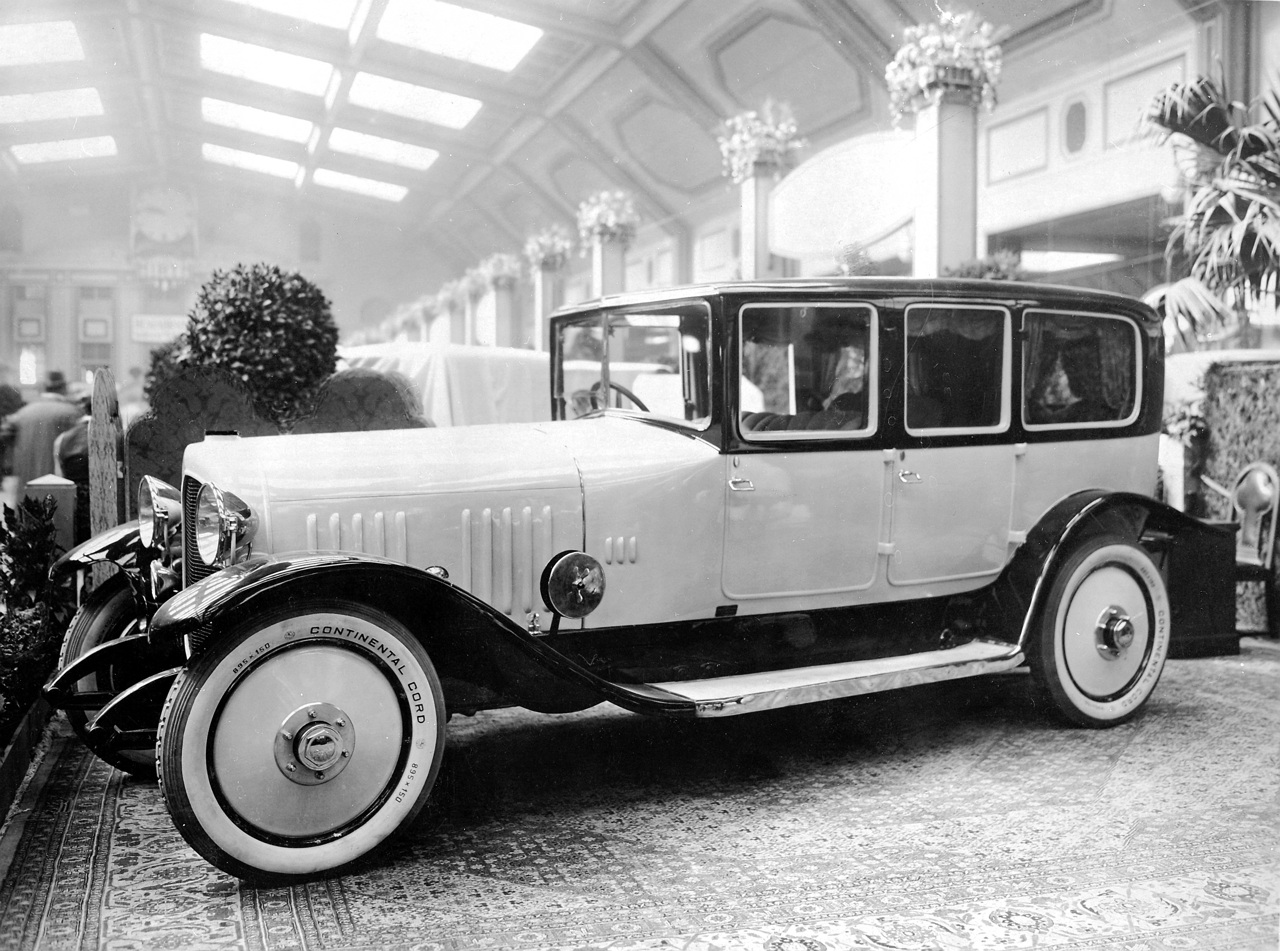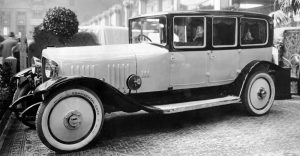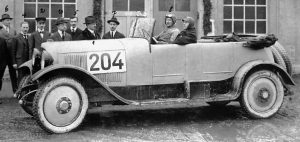
1919: Experimental car as nucleus for the construction of luxury automobiles
The first Maybach car engine was the six-cylinder side-valve engine W 1, which developed 46 hp (34 kW) at 2000 rpm. To test it, in 1919 the Maybach engineers built a test car which also was designated the W 1. From a historical viewpoint, this marked the beginning of automobile production under the brand name Maybach – even though the people at Friedrichshafen had no plans at the time to manufacture motor vehicles on their own. The next development project was the 5.7-litre W 2 engine derived from the W 1. It already delivered 70 hp (52 kW) at 2200 rpm.
In a long-term test in a chassis from Spyker, a Dutch brand, in 1920 the W 2 covered 30,000 kilometres in a record-setting 37-day run. In the wake of this demonstration of extraordinary reliability, Maybach entered into a contract with the Dutch manufacturer Trompenburg, maker of the Spyker cars. Maybach was to deliver a total of 1000 W 2 engines to power the Spyker 30/40 (C4) automobile. But the Dutch firm ran into financial troubles and took delivery of just 150 of the ordered units, not even managing to pay for all of them.
The first Maybach automobile presented in 1921 was dedicated to outstanding comfort and luxury from the start. On the basis of a historically evolved understanding of luxury and superlative quality, Mercedes-Maybach has always redefined the luxury of the future.

1921: Maybach 22/70 hp (W 3) model
Karl Maybach now decided to go into car production on his own to utilise the large production capacities that were lying idle as a result of the cancellation of the Dutch order. The new car brand was ready to unveil its first production car at the Berlin Motor Show in September 1921– the Maybach W 3. The five-metre-long vehicle that attained speeds of up to 110 km/h was powered by the 70 hp (52 kW) in-line six-cylinder W 2 engine. The innovative features of the W 3 included a four-wheel brake system with mechanical braking power compensation and a two-speed transmission without gearshift. Gears were changed by depressing a foot-operated starting lever.
Designed for simple operation and thus high driving reliability and safety, this car targeted the customer group of “gentlemen drivers”, as the manufacturer himself described them in his operator’s manual. This term refers to those men (and women) who drove their car themselves rather than by a chauffeur. Maybach offered them a technically convincing concept centring around the engine: “The exceptional flexibility of the engine in conjunction with effective four-wheel brakes permits high average cruising speeds without having to drive at excessively high speeds,” explains the operator’s manual.
Like many other car manufacturers of the period, Maybach viewed engineering alone as the company’s core competence. And so the manufacturer from Friedrichshafen left the fitting of a body to the chassis to independent specialists like Auer (Cannstatt), Josef Neuss (Berlin), Franz Papler & Sohn (Cologne) and – in many cases – Spohn (Ravensburg). In all, from 1921 to 1928 the company built around 300 units of the Maybach 22/70 hp, as the W 3 officially was called, based on taxable horsepower and actual output. Buyers appreciated the cruising qualities of the car, but some also used it successfully in motor sports.

Maybach Model 22/70 HP (W 3, 1921 to 1928)
When the Maybach Motorenbau company presented its first automobile as the Model W 3 in 1921, this new manufacturer already had a name well-known in the industry. Wilhelm Maybach, who had been chief designer of Daimler-Motoren-Gesellschaft in Stuttgart-Untertürkheim until 1907, and was known as the “king of designers” in the automotive world, founded the company with his son Karl in 1909. Initially father and son concentrated on the development and production of engines designed to power the Zeppelin airships, and these impressed with their quality and reliability. Shortly after the end of the First World War, the company built its first automobile engine and Karl Maybach decided to produce his own vehicles. Presented in September 1921, the five meter long Maybach W 3 with a top speed of up to 68 mph was powered by a 70 hp (52 kW) six-cylinder in-line engine. The innovative features of the first Maybach production car included an all-wheel braking system with mechanical brake force compensation and a two-speed transmission with no gearshift. The gears were shifted by fully depressing the starter foot pedal.
Like many other automobile manufacturers at the time, Maybach considered the core expertise of his company to lie in technology alone. As well as to the quality of design and finish, Karl Maybach attached great importance to outstanding comfort for the benefit of the driver and passengers from the very start. The Friedrichshafen-based manufacturer left it to independent coachbuilders to mount a body on the chassis, e.g. Auer (Cannstatt), Josef Neuss (Berlin), Franz Papler & Sohn (Cologne) and – very often – Spohn (Ravensburg). In total around 300 examples of the Maybach Model 22/70 HP, as the W 3 was officially called according to its taxable rating and actual output, were produced from 1921 to 1928. Its buyers appreciated the touring qualities of the car, but also used it successfully in motorsports. The W 3 was followed by further models that are regarded as decidedly luxurious – especially the Maybach Model 12 introduced in 1929. The flagship model produced from 1930 as the Maybach Zeppelin was the first production car with a V12 engine to be manufactured in Germany, and made the Maybach brand known worldwide as the place to go for luxury automobiles.

1926: Maybach 27/120 hp (W 5)
As second model alongside the 22/70 hp, in 1926 Maybach introduced the 27/120 hp with a newly developed seven-litre in-line six-cylinder engine. The internal designation did not follow the system of the W 3 model with the W 2 engine model, instead both vehicle and power plant were christened W 5. This car was an early indication of Maybach’s claim to leadership among the European manufacturers of luxury cars: “Indisputably, Maybach was the highlight of the show,” wrote the trade journal Motor in 1926 on presentation of the W 5 at the Geneva Motor Show.
Initially the new Maybach was offered with the two-speed transmission without gearshift, familiar from the W 3. In the W 5 SG of 1928 an overdrive transmission with dog-type shift mechanism complemented the two gears of the planetary gear group. This solution effectively resulted in four forward gears, but still made do without a clutch. Now the 27/120 hp could travel comfortably over longer distances at a top speed of 130 km/h.
Other manufacturers also used the Maybach overdrive transmission in their cars – including Mercedes-Benz, in the models 500 K, 540 K, 580 K and 770 “Grand Mercedes”.
Maybach (1919-1928) Gallery




You must be logged in to post a comment.